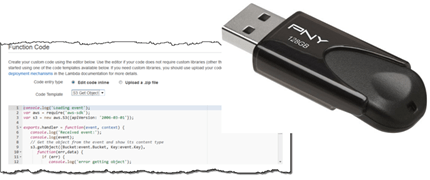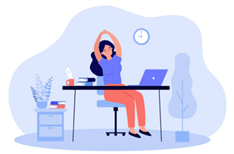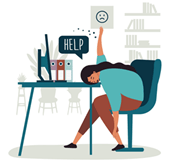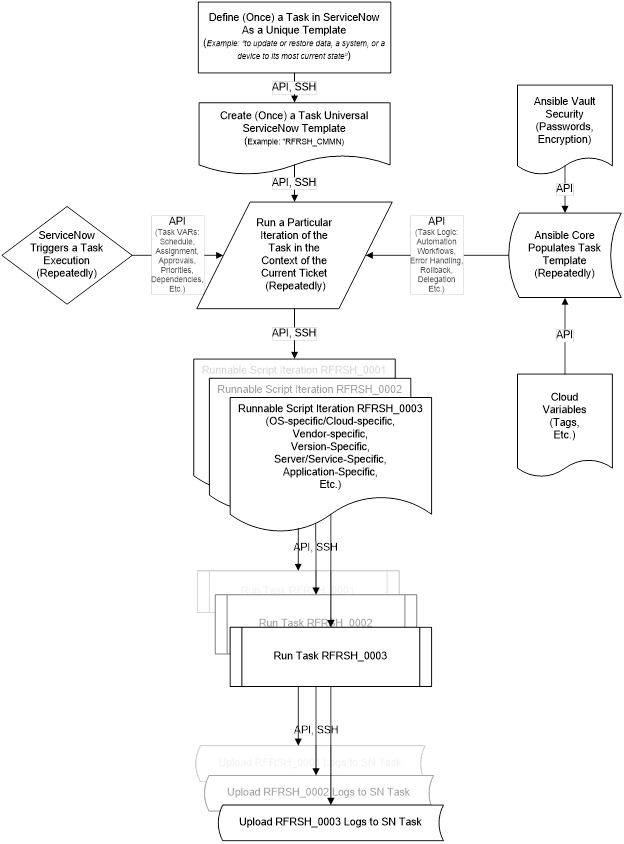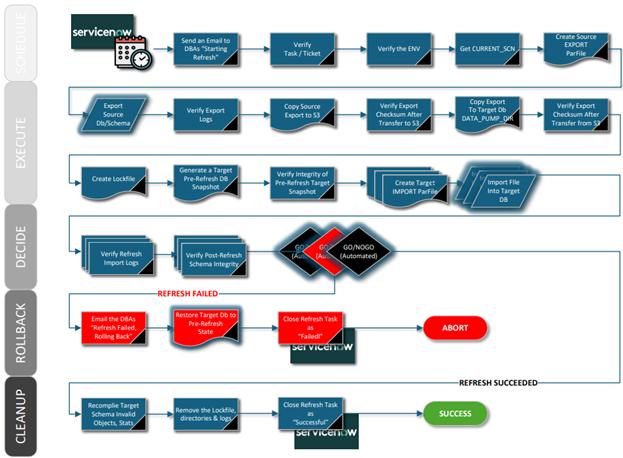Hyperautomation Technology
View our "1,000 Change Requests (Un)done in Under a Minute" challenge!
First off, Open Loop vs Closed Loop Automation - What is the Difference?
We make closed-loop automation software. The following video explains the difference between open (all current automation) and closed loop automation. Please view the demo for more details.
Definition: Open-loop automation is when an infrastructure is provisioned, deployed, and maintained without necessarily receiving feedback; and if feedback is received, an Open-loop will not take action on it, instead, it will require a human to look into it and take action; i.e. the loop is not only open, but it also REQUIRES HUMAN INTERVENTION to succeed. Closed-loop hyper automation, on the other hand, is when feedback is received and is taken into account for further action to be taken automatically by the controller WITHOUT ANY HUMAN INTERVENTION (other than the initial design of the automation logic itself, but not the task the said logic automates).
The Unique Benefits of Our Closed-Loop Hyper-Automation Modules
Definition: Open-loop automation is when an infrastructure is provisioned, deployed, and maintained without necessarily receiving feedback; and if feedback is received, an Open-loop will not take action on it, instead, it will require a human to look into it and take action; i.e. the loop is not only open, but it also REQUIRES HUMAN INTERVENTION to succeed. Closed-loop hyper automation, on the other hand, is when feedback is received and is taken into account for further action to be taken automatically by the controller WITHOUT ANY HUMAN INTERVENTION (other than the initial design of the automation logic itself, but not the task the said logic automates).
Replayable Closed-Loop Hyper Automation Modules, Versions & Core Features
(Click on the table below to expand)
People eat, sleep, vacation and sometimes ask for a raise. Our hyper-automation software is different. Automation doesn't understand the concept of "good enough" and it honestly thinks 9-5 are just random numbers. Everything it does, it will result in the best possible outcome. What does that mean to the IT manager? Imagine a year long project completing in a month. > Click |
You don't have to hire a team of professionals to routinely manually manage resource provisioning, configuration, troubleshooting, hardware setup, and so on. Automation saves time and money. How much money? Click to see just on example of what our software can do. > Click |
People commit mistakes. That's a fact. No matter much effort your team puts in, they are bound to make errors, several of them, in fact. In the case of Closed-Loop Automation, the definition files are a single source of truth. There is just always one file in one place. There's never any confusion about what they do. You execute them repeatedly and get predictable results every time. > Click |
Resource provisioning and configuration is often a labor-intensive and skill-intensive task, usually handled by higly paid and skilled resources. When one or more of them leaves the organization, they take their knowledge with them. Not only that, the years of training you've invested in the person will now benefit your competition from now on. With hyper-automation, resource provisioning intelligence remains with the organization in the form of definition files. > Click |
There is never any pointing fingers at each other with our software. When you need to trace changes to definition files, you can do it with ease. They are versioned, and therefore all changes are recorded for your review at a later point. So, once again, there's never any confusion on which module did what, when, where and for what ticket. > Click |
The load a current DBA team carries can be increased by 5%-10%. If you want more, you have to hire more DBAs. With a Closed-Loop implementation, you may increase your workload exponentially, before you even start considering a Control Node upgrade. > Click |
We use the AES256 symmetric encryption algorithm for securing all sensitive passwords, variables, secrets, API keys and other credentials in our Vault, preventing them from being exposed in plain text even once. > Click |
Supported Modules, Manifest
| AWS |
| Azure |
| Google Cloud |
| MySQL |
| Oracle OCI |
| PostgreSQL |
Technical Description and Intellectual Property(click to expand/collapse)PATENT: REUSABLE AUTOMATION MODULES FOR CONFIGURATION CHANGES OF IT ASSETSApplication # 63/856,135 USPTO Receipt COOPERATIVE PATENT CLASSIFICATION (CPC): G06F9/06 - Arrangements for program control, e.g. control units using stored programs, i.e. using an internal store of processing equipment to receive or retain programs Int. C. : G06F 15/16 (2006.01) H04L 2/24 (2006.01) H04L 12/26 (2006.01) HO4L 12/28 (2006.01) HO4L 12/58 2006.01) HO4L 29/06 (2006.01) ABSTRACTA system and methods for automating the provisioning, administration and maintenance of information technology (IT) assets within an enterprise is described. The method comprises the fixed steps of once defining a configuration change within the IT ticketing system and identifying the necessary tasks to enable the change; as well as the repeating dynamic steps of assigning the tasks their specific variables at run time, and then executing the resulting output scripts, and closing the main configuration change ticket. The method allows round the clock, vendor-agnostic unattended execution of changes in disparate systems, spanning multiple IT departments in real-time. BACKGROUND OF THE INVENTIONThe role of the ticketing systems has changed over time. Originally, in the physical on-premises world, the purpose of the helpdesk was three fold: making sure the ticket is approved by the rightful asset owner; then routing the work item to the correctly privileged team in full possession of the necessary technical knowledge; and finally, there is a record of the configuration change preserved in the ticket after it has been closed. The process worked as follows. A user would open a change request, for example to refresh a database from another. The ticket then would be routed to the database administration team. The management would approve the request and assign it to a person. The DBA then would schedule and execute the configuration change, upload the output logs and close the change request. In the physical world the Helpdesk was a digital switchboard, a place for a user to raise an incident, or for the IT professional to resolve it. INFLEXIBILITY OF CURRENT AUTOMATION OFFERINGSSlow, Compartmentalized, Single-Use Automation: It takes months or even years to properly automate a process (new versions come out, new requirements are raised, new API’s tested, etc.) When such a process is successfully automated, the effort and the code are rarely reused by other departments or business units. That means when it is time to automate the following application or business process, the enterprise automation department has to start from scratch. The ROI from the current automation offerings by the Cloud vendors may be described as “too little, too late and for too few”. SKILL GAPLack of Expertise: Organizations struggle to find qualified cloud automation and DevOps engineers, delaying initiatives and leading to potential security vulnerabilities. MULTI-CLOUD AND HYBRID COMPLEXITYUnified Management: Managing and governing infrastructure, data, and applications across various cloud platforms (multi-cloud) and environments (hybrid cloud) remains a significant hurdle. SECURITY AND COMPLIANCE CHALLENGESAttack Surface Expansion: Cloud environments expand the attack surface, requiring more robust security measures and automation for detection and response. COST OPTIMIZATIONCloud Waste: Identifying and eliminating unused or underutilized cloud resources is crucial to control costs and maximize the return on investment. AUTOMATION WORKFLOW MANAGEMENTCurrent Automation Software Inflexibility: All pre-packaged software or Cloud services need time to become fully integrated into an enterprise’s current platform. Without a doubt, in the context of the Cloud, automation plays a big role. However, while the services automate a large portion of traditional IT tasks, they don't entirely eliminate the need for technical expertise. Instead, they shift the focus of the administrator’s role from routine low level operational tasks to higher-level architectural decisions, performance optimization, and data governance. That is a business side of the IT industry that may not be appealing to the former on-prem DBA, and even if it is, it takes years to begin to understand that side of the IT business and decades to master it. Also, the Cloud DBA is expected to be very diverse in his/her knowledge, sometimes unreasonably so. After all, such complex automated workflows rarely include just one database vendor or service. There are hundreds of them now, all mutate and change every day, and a Cloud professional is actually expected to be an expert in all. The second factor that presents a significant challenge for the enterprise automation is its cost. Even if a company hired a small team of top notch DevOps professionals that worked exclusively on automating one business process, such an automation effort would require months or even years to document and code. All other work will have to be put on hold while that happens. A smaller company may not have enough time and resources for such a long running and expensive undertaking. A larger enterprise suffers as well, as almost none of the automation efforts are reusable. That implies an automation effort for one project or department is almost never reused by another. Consequently, the smaller companies can’t even afford to enter the custom enterprise automation market, while the larger enterprises are extremely inefficient at it. What is needed, therefore, are systems and methods of reducing the administrative and cost burden associated with IT tasks automation.
BRIEF SUMMARY OF THE INVENTIONEssentially, the current invention takes advantage of the fact that in the cloud everything is code. All configuration change requests are either raised on a schedule, or requested to be run once by a user. Both of these triggers may be coded in a Cloud-readable format. Once the task is raised, the system performs all the necessary organizational and functional pre-checks, obtains valid approvals, assigns the task an automation module, which performs all the tasks in their correct sequence. The invention consists of three resources: an existing ticketing system, an automation software unit and the actual asset, be it a service or an instance.
Conventionally, the work item was assigned to a person. Each such task iteration is considered entirely different in the conventional automation systems. For example, a refresh executed this quarter has a different task ID than the previous quarter. In ours, there is only one refresh, be it an Oracle database, Sybase, SQL Server or any other software. The role of the ticketing system is extended in our case. Our system stores reusable task templates for all major time consuming, repeating, hard to control tasks and processes – upgrades, refreshes, migrations, etc. Except, in our implementation, there is no administrator. Rather, the ticketing system assigns the work to automation software instead of a person (Ansible in our implementation). The automation software contacts the Cloud to get the asset tags, then contacts the Vault to securely retrieve the passwords, fills out the Ticketing System task template with its automation logic stored in YML playbooks, runs the resulting script iterations on disparate systems the second the task was opened and approved.
DETAILED DESCRIPTION AND BEST MODE OF IMPLEMENTATIONA list of common database task modules is developed – upgrades, patching, refreshes, code migrations, custom jobs, etc. Each such task is assigned a unique identifier. So, a RFRSH_DBS means a database refresh of some sort, for example, or an UPGRD_DBS implies a database upgrade. Then for every variation of the specific task - type, vendor, Cloud, version, etc – a workflow of general automation roles is pre-written. For example, if a company uses only two vendor and two version variations of database software, all four RFRSH_DBS task automation roles have to be pre-created. Each automated refresh role is a logical answer to the question “if money were no object, what would be the most efficient possible way to execute this job? In this case, there will be one Ansible playbook called RFRSH_DBS with four roles inside, each will work with a specific asset. At run time, the Ticketing System (ServiceNow in our example) determines which task template should be filled out with what Cloud asset tags to successfully run. The system then creates specific scripts and runs them in parallel on multiple assets, need be. Essentially, the Ticketing System decides whether or not to run, what to run, when and where; the automation unit decides how to do the job efficiently, in general, by what methods, in which order; and the Cloud asset tags, or the Ticketing System, feed the run-time variables. It is Ansible automation that runs the scripts, not a person. The logs then are uploaded to the Ticketing System. There is no administrator in our implementation. The modern IT enterprise is too diverse, complex and ever-changing to efficiently maintain with people’s knowledge. In addition to opening, approving, auto-assigning and executing a specific configuration change, the system keeps track of dependencies between tasks. Such dependencies may span multiple departments or IT teams. The following describes such task dependencies. The budgetary, operational and functional automated pre-checks may include such business rules such as “never refresh PROD from a lower environment database”.
CLAIMSThe algorithms and operations presented herein are not inherently related to any particular computer or other system or apparatus. Various general-purpose systems may also be used with programs in accordance with the descriptions herein, or it may prove convenient to construct more specialized apparatus to perform the required method steps. The required structure for a variety of these systems will be apparent to those of skill in the art, along with equivalent variations. In addition, embodiments of the invention are not described with reference to any particular programming language or software vendor. It is appreciated that a variety of programming languages may be used to implement the present teachings as described herein, and any references to specific languages are provided for disclosure of enablement and best mode of embodiments of the invention.
Pic. 4. Claims REDACTED END OF PATENT PATENT: SYSTEM AND METHODS FOR AUTOMATED APPROVALS OF IT CONFIGURATION CHANGES
COOPERATIVE PATENT CLASSIFICATION (CPC): G06F9/06 - Arrangements for program control, e.g. control units using stored programs, i.e. using an internal store of processing equipment to receive or retain programs G PHYSICS G06 COMPUTING; CALCULATING OR COUNTING G06F ELECTRIC DIGITAL DATA PROCESSING
Int. C. : G06F 15/16 (2006.01) H04L 2/24 (2006.01) H04L 12/26 (2006.01) HO4L 12/28 (2006.01) HO4L 12/58 2006.01) HO4L 29/06 (2006.01) U.S. C.: H04L 12/24 (2013.01); H04L 12/2602 (2013.01); H04L 12/2801 (2013.01); H04L 41/00 (2013.01); H04L 41/046 (2013.01); H04L 41/048 (2013.01); H04L 41/0654 (2013.01); H04L 41/0813 (2013.01); H04L 41/082 (2013.01); H04L 41/0803 (2013.01); H04L 41/0806 (2013.01); H04L 51/00 (2013.01); H04L 51/04 (2013.01); H04L 51/046 (2013.01); H04L 65/40 (2013.01); H04L 65/403 (2013.01) USPC.: 709/223; 709/201; 709/202; 709/203; 709/205; 709/206; 709/217; 709/218; 709/219; 709/224; 709/225; 709/227; 705/305; 705/30; 705/32; 705/7.13; 705/7.14; 705/7.16; 718/100; 718/102 FIELD OF THE INVENTION: This patent application introduces a novel approach to automating and deploying IT solutions, offering unique features and benefits in the field of information technology (IT) systems.
ABSTRACTA system and methods for pre-approving closed-loop automated configuration changes of information technology (IT) assets within an enterprise are described. The method comprises the steps of creating operational and iterative approval policies within a Helpdesk ticketing system; then using both for one time pre-approval of an automation workflow designed to run repeatedly. The method allows a continuous reuse of prior approvals and leads to increased deployment efficiency, reduced lead times, faster time to value and minimizes change failures.
BACKGROUND OF THE INVENTION
To accelerate IT tasks and changes, organizations can optimize their change approval policies by leveraging automation, defining clear approval workflows, and implementing dynamic routing based on risk and impact. This involves identifying low-risk changes that can be pre-approved, automating approvals based on predefined criteria, and routing high-risk changes to the appropriate stakeholders or Change Advisory Boards (CABs). The following are some of the recent strategies being implemented by organizations to significantly reduce the time it takes to approve and implement IT changes, leading to faster delivery of services and improved business outcomes.
Risk-based categorization: Classify changes based on their potential impact and risk level (e.g., low, medium, high). Automated approvals: Pre-approve low-risk changes that meet specific criteria, eliminating manual intervention. Dynamic routing: Route changes based on predefined rules to the relevant approvers, ensuring appropriate oversight and faster approvals. Standardized workflows: Establish clear, documented workflows for different change types to ensure consistency and efficiency. Delegation of authority: Allow for delegation of approval authority to ensure timely approvals, even when key personnel are unavailable. Reduce manual steps: Minimize manual intervention by automating approvals and leveraging technology. Regularly review and refine: Continuously monitor the change approval process, identify bottlenecks, and make adjustments to improve efficiency.
The approaches above helped the enterprise in delivering a better quality of service in a shorter period of time. However, they fell short at automating of long-running, complex workflows spanning multiple departments or even BUs for two reasons, or, rather, in two domains: a) Time domain. The current approval methods are designed for one time execution, while automation executes tasks repeatedly, sometimes in different contexts or asset combinations, requiring a different set of necessary approvals for each such task iteration. b) Ownership domain. The current approval process is lacking in the sense the conventional or even open-loop automation approval is granted to a department or a person (sometimes even linked to an administrators employee ID), but closed-loop automation is neither a person or department.
Clearly, these barriers were raised to make sure only the authorized personnel in full possession of the valid credentials and the necessary technical expertise will execute the task. Otherwise, it may be done incorrectly or even not done at all. But with the advent of the Cloud automation, when everything is 01 and 1s the administrators knowledge, the asset itself, the passwords all of these barriers designed to protect the asset and technology from us is now hurting us because of its inefficiency. In the Cloud, there are thousands of assets with hundreds of tags, each ever changing. It is an insurmountable challenge to keep track of all of the new risks involved in these technologies and assets. That is why an automated method of approvals is necessary. In an effort to resolve these deficiencies, either the workflow has to be approved in its entirety ahead of the launch of the executions as a template, or each iteration ((re)execution) of an automated workflow has to be (re)approved separately, in real-time, before it can run (the latter will slow down the automation speed significantly, even with existing pre-approval policies already in place).
BRIEF SUMMARY OF THE INVENTION
The current invention is designed to work as follows. Instead of approving each occurrence of a task separately, the process is designed to approve the task as a template (meaning its operational approval policy within the ticketing system), and additionally we also approve how this task or process is allowed to iterate (the iterative approval policy). To put it simply, instead of repeatedly approving a task every time, we simply once 1) define what a task is in a broader sense in the context of the enterprise (a refresh, for example); 2) define how it is run each time to consistently produce a desired/different result; 3) define once by what criteria a particular task iteration is either APPROVED or REJECTED. Then we simply inspect each automated workflow JSON/YML code to determine whether or not the particular iteration code should be approved or rejected automatically. An operational policy for a database refresh, for example, would define which department may refresh its data from what other department (but not necessarily when, by what means and methods). An operational policy is a subject of discussion between two VPs, for example. An iterative policy, on the other hand, would define how this particular iteration of the main refresh is to be executed from what tools, versions, to specific asset variables, naming conventions and tags.
Pic. 1. Decision flow for APPROVING or REJECTING a Close-Loop Automated Approval Process CLAIMS<REDACTED> |
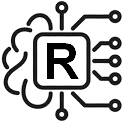

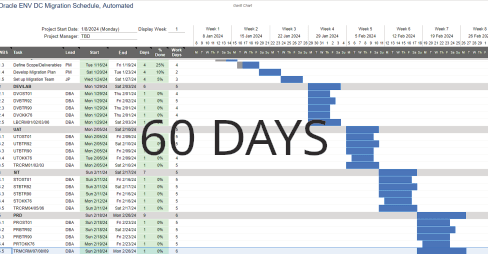
 .
. 

